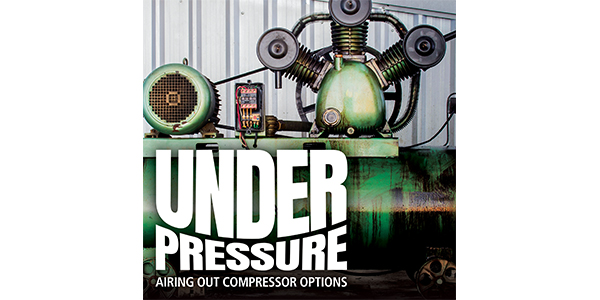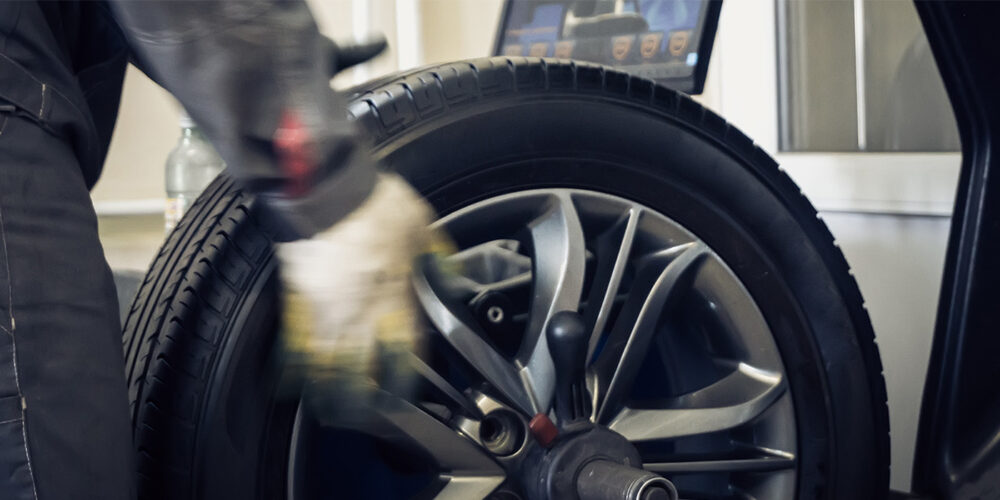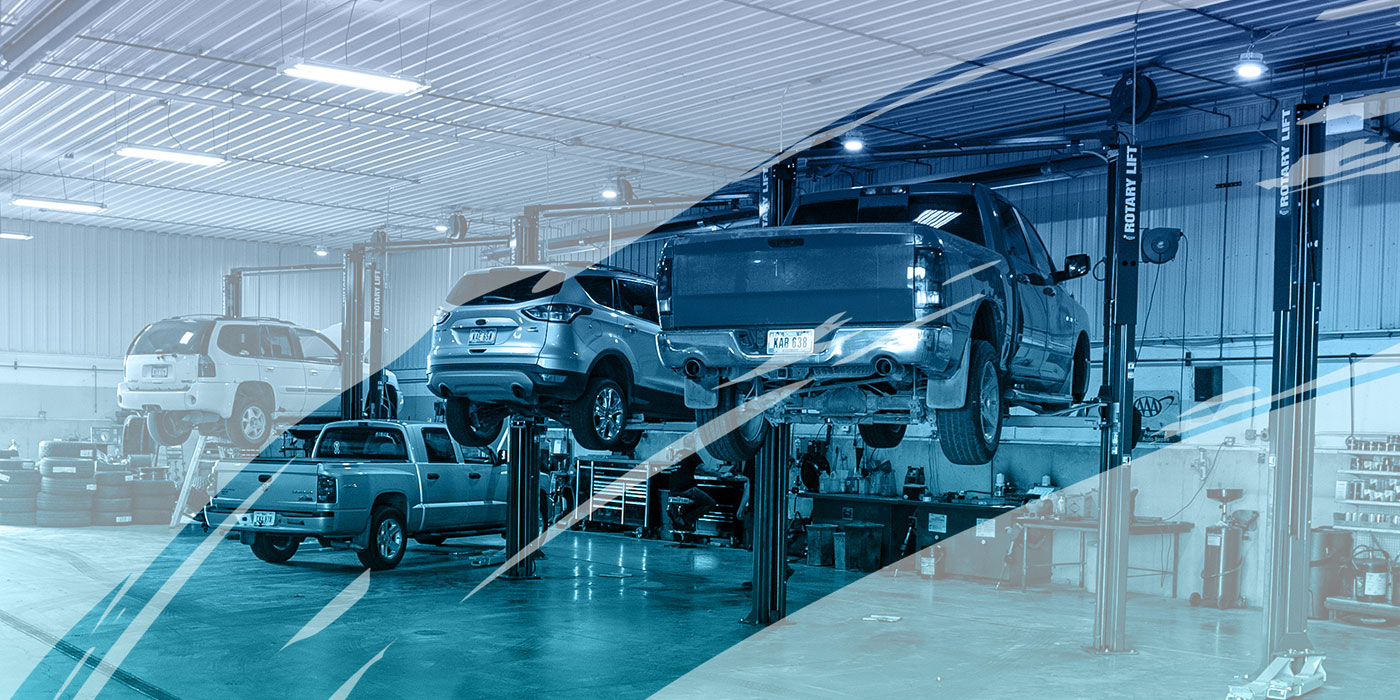
The air compressor; it’s the lifeblood of any shop and arguably the most important piece of equipment you have. We all know the value of compressed air and whether you’re setting up a new shop, replacing worn-out equipment or just getting something for home use, choosing the right one is an important decision.
There are more and more compressors showing up on the market every day, giving us a lot to think about when it’s time to get one. Endless choices from multiple sources can make it difficult, but understanding the differences will make it easy for you to determine what is best for your application.
The two main categories of air compressors you’ll be choosing from are the reciprocating and the rotary screw. The oldest type of compressor is the reciprocating, or piston type, which is found in the majority of automotive and home repair shops. The rotary screw compressor is typically used in factory or production situations, with their operational aspects generally making them better suited for those applications.
Reciprocating Compressors
Reciprocating compressors operate like an internal combustion engine with a piston, connecting rod and crankshaft, the primary difference being the valve block (in place of a traditional cylinder head), which allows the intake and output to occur strictly based on the pressure in the cylinder. The crankshaft is driven by an external power source, such as an electric motor or small gasoline engine.
These are the most common because of a few simple facts: they work well, they are durable and they are dependable. The original design aspects of these include oil lubrication, air-cooling and cast iron construction and although many attempts have been made, they can’t be beat. In short, they are “tried and true.”
Within this field of reciprocating compressors, you’ll see the terminology single-stage and two-stage. Single-stage means that the pressurized air output from the cylinder is delivered straight into the compressor tank. Two-stage means that the pressurized air exiting the cylinder is cooled, then pushed into a second smaller cylinder, which compresses it to a much higher pressure.
The number of cylinders on a single-stage compressor can vary, the greater the number, the higher the volume of air that can be produced. Two-stage compressors will have a minimum of two cylinders but may have more to increase their volume output in addition to their higher-pressure capability.
The advantage of a two-stage compressor is higher pressure and cooler running temperatures, making them better suited for heavy-duty applications.
A variant of the reciprocating compressor is the oil-free type. The difference with this design is that these compressors have a one-piece piston and connecting rod with an eccentric bearing in the crankshaft end of the rod. This eliminates the oil and the need for a crankcase, saving weight and reducing maintenance. Instead of an oil ring and compression ring on the piston, these have a Teflon sealing ring between the piston and cylinder wall.
The most common example of these is what is widely known as a “pancake” compressor, a small, lightweight compressor with a small (one to six gallon) tank, used for applications that do not require a large volume of air. These oil-less compressors come in a variety of sizes, the largest of which will have about a 20- or 25-gallon tank. These are designed and work well for portability and light duty and are also the least expensive types of compressors.
Reciprocating compressor options are abundant, from portable to fixed mount, powered by electric motors or gasoline engines and are available in direct-drive or belt-driven configurations.
Rotary Screw Compressors
Just saying “rotary screw compressor” may not sound that exciting, but if I said “supercharger,” I bet it would get your attention. Now you picture what we’re talking about. A rotary screw compressor works very similar to a rotary screw supercharger. As the screws rotate side by side, the air is drawn into a chamber that increases in size as it moves down the length of the screw. As soon as the chamber is full, the air is trapped in and the natural rotation and mesh of the screws decreases the size of the chamber on the output side, pressurizing the air and forcing it into the storage tank.
Here’s where it gets tricky. By design, these compressors will generally exhibit a characteristic called oil carryover. During operation, oil is injected into the compression chamber to aid in sealing and cooling. Some of this oil is carried into the compressed air.
In order to remove the oil from the air, the compressor will have to incorporate an oil separation process. This internal function affects the performance of the compressor and is quite often forgone so better performance can be cited. This requires an oil separation system after the compressor, and the oil in the compressor must be topped off on a regular basis.
The advantage to these compressors is they run quieter than the reciprocating type and they generate much less heat, making them great when operating for extended periods of time, which is why they are ideal and more common for industrial applications.
To give rotary screw compressors their fair shake, they are available with oil-free technology that will provide you with clean air for your shop and we love the technology, but if you are considering one of these, it is vital that you do your research.
What to Compare
With so many options of compressors, you may wonder, “Where do I start?” You can easily narrow down your decision by answering the question, “What am I using the compressor for?”
Light-duty, infrequent-use applications such as nail or staple guns and tire inflation points toward a small, oil-free portable compressor. If you are going to be using a few light-duty air tools, you’ll want to make sure it has a 20- to 30-gallon tank.
Stepping up to more frequent use and any type of sanding or grinding, a single-stage, oil-lubricated, fixed-mount model with a larger, approximately 60-gallon tank will be needed to fit the bill.
Heavy-duty use for shop applications is when a two-stage, oil-lubricated, fixed-mount model with a large, approximately 80-gallon or larger tank is required.
To really be sure you get what you need, you can calculate the CFM (cubic feet per minute) requirement of your shop. All air tools and equipment will provide you with the CFM that they require for operation. Approximate the number of tools that will be used at any given point in time, add together their CFM requirements and you’ll be looking at the most important number for compressor performance. This number will be listed along with all other compressor specifications on any model you are looking at.
Additional Factors
There are a few final things to consider. Don’t forget to confirm that you have the proper electrical service available for the compressor you choose. Consult an electrician if you are not sure.
Be sure to understand all maintenance requirements for the unit you are looking at. Proper oil changes, belt adjustments and air filter changes are critical to long service life.
Keeping the tank drained is another critical maintenance factor. All models have at least a hand-operated petcock for draining, some higher end models are available with electric-timed drain valves, which can save you a lot of time.
Once you have considered all of these options, you should be able to quickly narrow down your choices and finally concentrate on a few determining factors to select the right unit and keep your shop under pressure.













